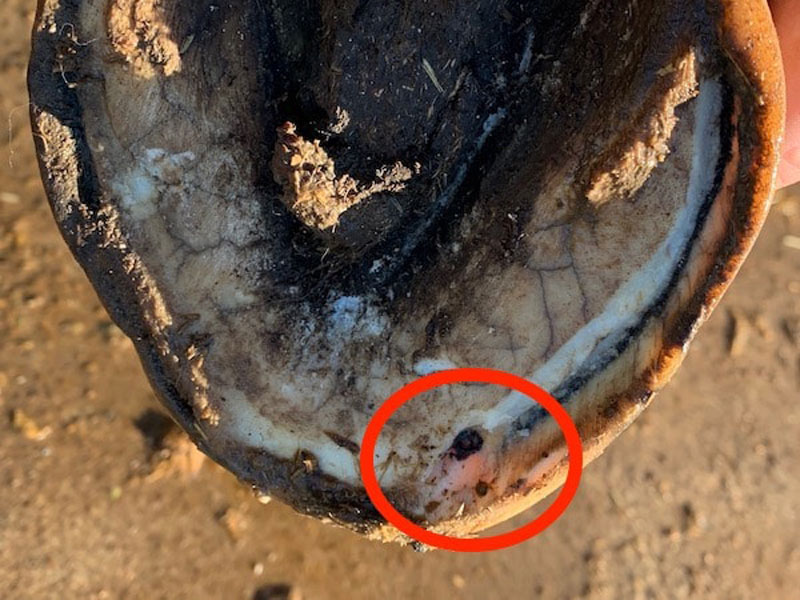An abscess within the hoof is one of the most common causes of sudden, severe lameness in the horse. It is an infection in the sensitive tissue of the hoof, which develops into a pocket of purulent material (pus) within the hoof capsule. Whilst the volume of pus is often only quite small, the pressure build-up that it causes within the hoof capsule is extremely painful and often results in significant lameness.
Signs of a hoof abscess can include:
- Severe lameness (often quite sudden in onset), some horses are reluctant to bear any weight at all on the affected leg
- Hoof wall may feel hot to touch
- Generalised swelling at the pastern/fetlock
- Digital pulses may be prominent
What causes a hoof abscess?
An abscess/Infection is caused by commensal bacteria which normally live in the environment or on the surface of the foot. Bacteria are introduced most often through a hoof crack, by tracking through the white line, by a puncture wound to the sole, or by a nail ‘prick’ at shoeing. Hoof abscesses seem to be more common in the wetter months as there is a lot more mud around and the expansion and contraction of the hoof in response to moisture can help facilitate abscess formation.
How is a hoof abscess diagnosed?
Often the history and severity of the lameness is crucial. Assessing the horse’s digital pulses to detect inflammation (throbbing) in the foot and for any areas of heat. Hoof testers are a tool we use to locate any discrete area of pain. By applying gentle pressure and assessing the horse’s pain response we can often pin-point the area of concern.
If shod, the shoe must often be removed, and the sole cleaned and searched. There may be signs of a puncture wound, crack or area of discoloration at the white line, corresponding to the area of pain. A hoof knife is then used to investigate any areas of concern for pockets of pus/ooze.
Occasionally the abscess cannot be located immediately, and the foot should be poulticed for a period of time to help the abscess to ‘ripen’ and the foot to soften, before trying again to find the abscess. If the abscess still cannot be found, a radiographic examination (x-ray) of the foot may be made to look for a pocket of pus/gas and to rule out other possibilities, e.g., fractures of the bones in the foot.
If left untreated, the infection may track upwards and break out at the coronary band. In some instances, the infection may track into the pedal bone. If the pedal bone is implicated, it can have serious consequences and require long term medical care. In other cases, the infection may track along under the sole (‘under-run sole’) causing long term lameness and a slow recovery. Early intervention by your equine vet will give the best chance of success!
How can a foot abscess be treated?
Once an abscess has been located and identified, a small section of the overlying sole is pared away with a hoof knife to allow efficient drainage. This process is often painful but subsequently will result in dramatic improvement once the pressure of the abscess has been released.
- Antiseptic soak: Soaking the foot in an iodine (betadine) bath/bucket for 10-15 minutes is recommended and should also be done between poultice changes.
- Poultice: Following opening of the abscess, the hoof should be poulticed for 24-48 hours to encourage thorough drainage through the hole. This poultice may need ongoing changes until the area appears to have ceased draining.
- Anti-inflammatories: Phenylbutazone (bute) is indicated to aid in reducing inflammation in the foot and improving the horse’s comfort. It will also help prevent supporting limb laminitis (laminitis in the contralateral foot from taking all the horse’s weight).
- Antibiotics: Indicated in cases of septic pedal osteitis (infected pedal bone) or where there is significant evidence of infection within the soft tissue structures of the foot.
- Tetanus: If the horse is not fully vaccinated or if vaccination status cannot be confirmed then a tetanus antitoxin should ideally be given, along with a tetanus toxoid.
The horse should be kept in clean dry conditions until the hole has healed and then the foot may be re-shod. The degree of lameness should improve rapidly within 12-24 hours after the abscess is opened and the pus is drained. If this is not the case there may be a more serious problem, requiring more extensive investigation.
How can foot abscesses be prevented?
You should pick out and examine your horse’s feet every day if possible. Make sure that your horse’s feet are regularly trimmed and shod, by a qualified farrier, to help prevent hoof cracks from occurring.
Call the team at Southwest Equine Veterinary Group to investigate any lameness your horse may be suffering from. In the case of an abscess, this may help prevent complications such as septic pedal osteitis, under-run sole and/or supporting limb laminitis.

